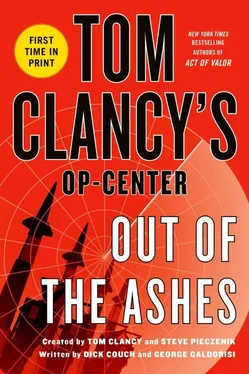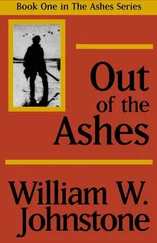“Then my final request is this, and I’ll say this carefully, sir. I have picked Paul Hood’s brain extensively, and part of the reason the old Op-Center ultimately failed was, personalities aside, it presented a threat to the intelligence community and to the Pentagon. You have the authority to revive Op-Center. However, if you want it to succeed, you’re going to have to get your national security team, your intelligence community, and your military chiefs on board. I can’t do that, sir. Only you can.”
Midkiff considered this. He knew Williams was right, but it was easier said than done, even for the commander in chief. “I think you’re on the right track, but give me some time to think about just how to go about this.”
“I understand, Mr. President. Here is a memo that captures the concept of operations for Op-Center. It contains everything we just discussed, and the mechanics for putting these procedures into place.”
“Thank you for this. I’m virtually certain we’ll get the kind of buy-in you want. Once we do, how soon do you think you can get Op-Center up and running?”
“If you have the resources, give me just three months and I can have a skeleton organization going. In eight to ten months we can be fully functioning.”
“I know this is an ambitious undertaking. I’ve already consulted with the House and Senate majority and minority leadership. None of them want to see attacks like these happen again. You won’t have a blank check, but move forward aggressively and let us worry about resourcing Op-Center.”
“Thank you, Mr. President. I appreciate your vote of confidence. It’s three months and eight to ten months, then — less if I can make it work. And I’ll try not to give you sticker-shock over my hires for the Geek Tank.”
“That’s an ambitious timeline, Chase, and I’ll hold you to it. As for your Geek Tank, get the best minds you can working on this. We can’t give them stock options, so pay what you must to get them on board.”
Their meeting complete, the president walked Chase Williams to the door of the Oval Office. Williams had done his part. Now it was up to Wyatt Midkiff to do his.
* * *
Late that night, forty miles southeast of the White House, near Mechanicsville, Maryland, there was no moon, few stars, and enough low fog to obscure almost everything on the ground.
“Altitude, altitude!” the crew chief shouted to her pilot as he brought their UH-60 Black Hawk helicopter into a hover over the warehouse. She was a veteran with thousands of hours in the air, yet her voice had an urgent screech to it.
“Got it,” the pilot replied into his lip mic as he pulled collective and stabilized the bird in an eighty-foot hover over the roof of the massive building. Stay on the instruments, he said to himself, willing himself not to look out into the inky blackness surrounding their helicopter. Don’t fight the controls. EASY with it.
“Now!” he said, working to keep the emotion from his voice.
The crew chief turned in her seat and looked back into the cabin where eight members of the FBI’s Critical Incident Response Group waited for the signal. The HRT — Hostage Rescue Team — all wore black coveralls, Kevlar helmets, and their faces were either blackened or hidden by balaclavas. The team’s primary weapons were the same, the Special Operations Peculiar Modification M4 carbines with SU-231 EO Tech holographic sights and LA-5 IR lasers/pointers. The FBI armory had newer rifles, but most on the HRT team were former special operators or SWAT veterans, and the SOPMOD M-4 was what they were used to and what they were comfortable with. Their secondary weapons strapped to their thighs ranged from Glocks to SIG SAUERs to a 1911.45. They wore body armor and Rhodesian vests with an impressive array of urban assault gear. All had PSC-15 night vision goggles.
She pulled an infrared light from her torso harness and, leaning from her cabin perch, signaled the ground, moving the light in a circular motion. As she did, the assault team in the back of the Black Hawk kicked out two hundred-foot-long, four-inch-thick braided nylon fast-ropes. Seconds later, four HRT members slid down each length of rope and landed on top of the warehouse. They were like drops of oil coming down a string. The last man down brought a section of climbing rope.
As the team on the roof signaled all clear, the pilot pulled collective and lifted the Black Hawk into the dark sky above.
On the roof, the team leader split his men into two groups. He took four other men with him as they scrambled down the climbing rope to the ground while his number two led two other men to the one skylight on the roof.
On the deck, the team leader positioned two of his men in front of the main warehouse door. A third man put a small explosive strip-charge on the door, ready to breach the door at his leader’s command. When the two men nodded they were ready, he whispered into the boom mic of his squad radio, “Now.”
“Now,” repeated his number two on the roof.
On the ground level, the door blew back into the building. The team poured into the room, sweeping the interior with their M4 rifles. They then began the well-choreographed actions of clearing the first room and moving on to the next, and the next.
On the roof, the number two man lifted the skylight and tossed in two flash-bang stun grenades. Immediately following the explosions, the second team kipped through the opening and dropped to the floor of the room below.
Inside the warehouse it was twenty seconds of measured violence as the teams moved from room to room — shooting, clearing, and marking bodies of the fallen. Then calls of “clear” came from various points inside the building.
The chattering of the rotor blades grew louder as the Black Hawk descended into the vacant parking lot adjacent to the building. As the crew shut down the bird’s engines and the blades began to coast to a stop, shrill whistles blew from inside and outside the building. Then came the loud announcement, “Exercise over — EndEx, EndEx.”
The exercise coordinator walked up to the team lead. “Congratulations, you killed the terrorists and also half the hostages.”
They all knew it would be a long debrief back at the Quantico CIRG team facility.
The White House Oval Office, Washington, D.C.
(January 14, 0900 Eastern Standard Time)
Wyatt Midkiff sat in the Oval Office. He was anticipating a meeting he knew he needed to have, but one he was not looking forward to.
He had used his considerable political and social skills over the past six weeks to calm his national security advisor’s concerns. Yet he knew Trevor Harward was still anxious about this new venture. Punctual to the minute, Harward entered the president’s office at precisely 0900.
“Morning, Mr. President. How did your meeting with Admiral Williams go?”
“It went well, Trevor; actually, better than expected. I asked the admiral — and by the way, he prefers being addressed as Chase — to draft up a memo capturing what we discussed and get it to you by the end of the week. I think we are ready to move forward with Op-Center.”
“That’s good, Mr. President. I think it’s something we both believe the nation needs.”
“I agree, Trevor. However, you’re my national security advisor, and I want to ensure we both come to an understanding regarding the way we want to use Op-Center and the relationship I’ll have with Chase Williams.”
“Mr. President, I appreciate you raising this. I admit I initially found Chase’s directness and insistence that he come directly to you when he felt the need a bit off-putting. However, as you and I have talked about this over the past six weeks, I recognize you should have the option of communicating with him, and only him, directly if the situation demands it.”
Читать дальше












